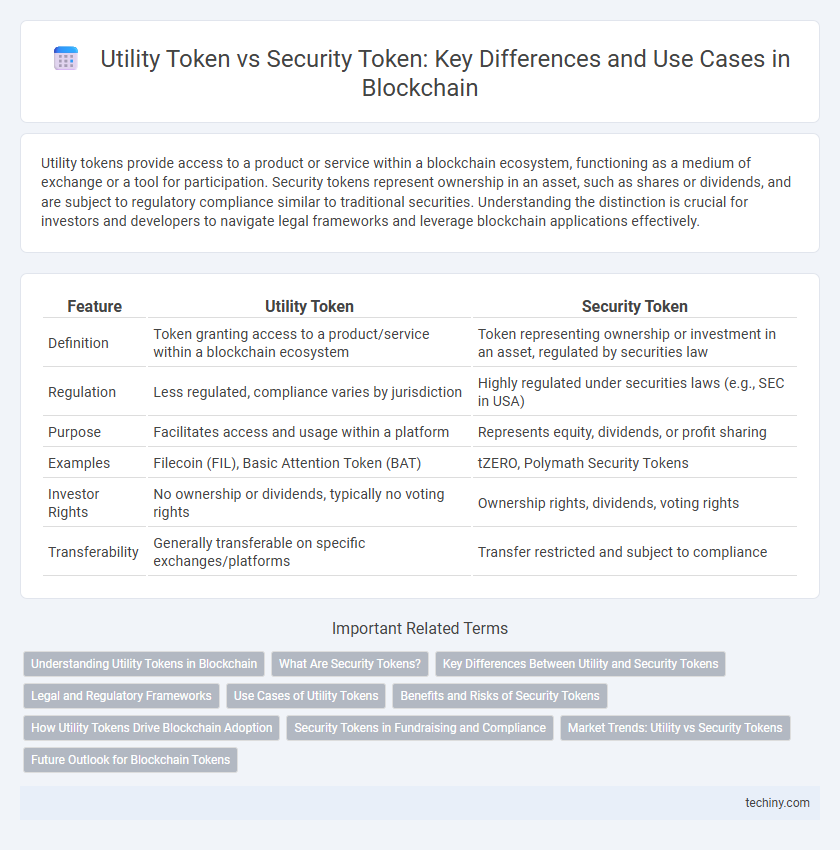Utility tokens provide access to a product or service within a blockchain ecosystem, functioning as a medium of exchange or a tool for participation. Security tokens represent ownership in an asset, such as shares or dividends, and are subject to regulatory compliance similar to traditional securities. Understanding the distinction is crucial for investors and developers to navigate legal frameworks and leverage blockchain applications effectively.
Table of Comparison
| Feature | Utility Token | Security Token |
|---|---|---|
| Definition | Token granting access to a product/service within a blockchain ecosystem | Token representing ownership or investment in an asset, regulated by securities law |
| Regulation | Less regulated, compliance varies by jurisdiction | Highly regulated under securities laws (e.g., SEC in USA) |
| Purpose | Facilitates access and usage within a platform | Represents equity, dividends, or profit sharing |
| Examples | Filecoin (FIL), Basic Attention Token (BAT) | tZERO, Polymath Security Tokens |
| Investor Rights | No ownership or dividends, typically no voting rights | Ownership rights, dividends, voting rights |
| Transferability | Generally transferable on specific exchanges/platforms | Transfer restricted and subject to compliance |
Understanding Utility Tokens in Blockchain
Utility tokens in blockchain serve as digital assets that provide users access to specific products or services within a decentralized platform, differentiating them from security tokens which represent investment contracts subject to regulatory oversight. These tokens enable functionalities such as transaction fees, access rights, and participation in ecosystem governance, thereby enhancing user engagement and platform utility. Understanding the role of utility tokens is crucial for developers and investors to navigate blockchain ecosystems effectively and leverage their potential without triggering securities regulations.
What Are Security Tokens?
Security tokens represent ownership in an underlying asset such as equity, real estate, or debt, regulated by securities laws to ensure investor protection. These tokens confer rights similar to traditional securities, including dividends, profit sharing, or voting rights, making them subject to strict compliance and reporting requirements. Security tokens bridge the gap between blockchain technology and conventional financial markets by digitizing assets and enabling fractional ownership with enhanced transparency and liquidity.
Key Differences Between Utility and Security Tokens
Utility tokens provide users access to a product or service within a blockchain ecosystem, functioning as a digital coupon or membership card. Security tokens represent ownership in an asset, often entitling holders to dividends, profit sharing, or voting rights, and are subject to securities regulations. The primary difference lies in their purpose and regulatory treatment, with utility tokens focusing on usage rights and security tokens being investment vehicles.
Legal and Regulatory Frameworks
Utility tokens grant holders access to a platform's services without representing ownership or profit rights, often falling outside strict securities regulations. Security tokens represent investment contracts or assets with profit expectations, subject to comprehensive legal frameworks like the SEC's oversight in the U.S., requiring compliance with securities laws. Differentiating between these tokens hinges on regulatory criteria such as the Howey Test, influencing registration obligations and investor protections.
Use Cases of Utility Tokens
Utility tokens primarily serve as access keys to specific blockchain-based services or products, enabling users to participate in decentralized applications or platforms without conferring ownership rights or dividends. Common use cases include granting access to software features, facilitating transactions within virtual ecosystems, and incentivizing user engagement through rewards or loyalty points. Their design focuses on functional value within a network, distinguishing them from security tokens that represent investment contracts subject to securities regulations.
Benefits and Risks of Security Tokens
Security tokens offer enhanced regulatory compliance and investor protection by representing ownership in real assets or equity, providing benefits such as increased liquidity and fractional ownership. However, they carry risks including stringent regulatory requirements, potential legal complexities, and market volatility impacting token valuation. Investors must weigh the trade-offs between legal safeguards and the challenges of navigating evolving securities laws in the blockchain ecosystem.
How Utility Tokens Drive Blockchain Adoption
Utility tokens facilitate access to blockchain-based products and services, incentivizing user participation within decentralized ecosystems. By enabling transactions, governance, and rewards, utility tokens create active communities that foster innovation and scalability. Their non-investment nature reduces regulatory hurdles, accelerating blockchain adoption across various industries.
Security Tokens in Fundraising and Compliance
Security tokens represent ownership in real assets or enterprises, providing investors with regulated and compliant opportunities in blockchain fundraising. These tokens adhere to securities laws, ensuring transparency, investor protection, and reducing legal risks for issuers during capital raising. Security tokens facilitate automated compliance through smart contracts, enhancing efficiency in fundraising processes compared to traditional securities.
Market Trends: Utility vs Security Tokens
Utility tokens dominate blockchain markets by enabling access to specific platform services, driving demand in decentralized finance (DeFi) and gaming sectors. Security tokens, regulated as investment contracts, attract institutional investors due to their compliance with securities laws and potential for dividends or asset backing. Market trends indicate growing investor interest in security tokens for regulated asset digitization while utility tokens maintain strong adoption in consumer-driven blockchain applications.
Future Outlook for Blockchain Tokens
Utility tokens are expected to drive decentralized application ecosystems by enabling access to platform services and incentivizing user participation, fostering innovation in blockchain-based services. Security tokens, representing ownership in assets, are poised to transform traditional finance through improved liquidity, transparency, and regulatory compliance, attracting institutional investors. The future outlook for blockchain tokens indicates a convergence of utility and security functions, with hybrid models emerging to meet evolving regulatory frameworks and market demands.
Utility Token vs Security Token Infographic

 techiny.com
techiny.com